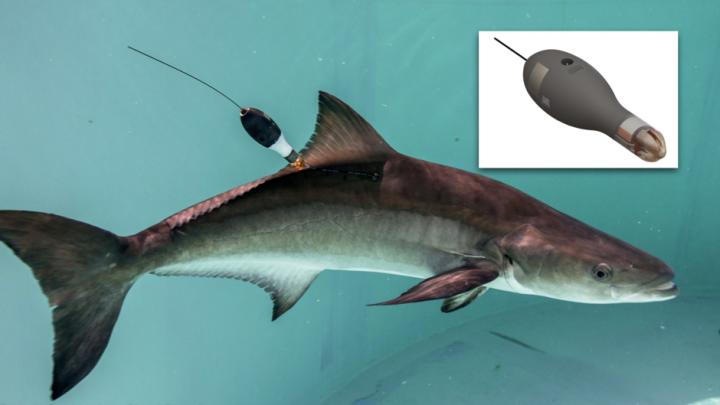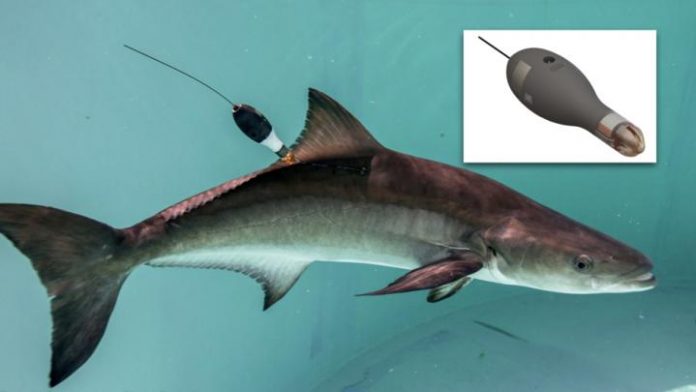
Photo: Cobia (Rachycentron canadum) equipped with ATS enabled PSAT during captive validation trials.
view more
Credit Image: Matt Bernanke – SharkTagging.com
MIAMI–Scientists at the University of Miami (UM) Rosenstiel School of Marine and Atmospheric Science and Wildlife Computers, Inc. today announced the release of a new activity data product application for marine animal tracking. The technology is designed to remotely track and transmit data gathered on an animal’s activity levels over several months along with the temperatures and depths they experienced.
Determining if and how marine animals change their activity levels in response to varying environmental conditions like temperature is important for understanding and predicting their responses to global warming and other environmental changes.
“The new feature available on the Wildlife Computers MiniPAT pop-up tag has an integrated accelerometer for measuring activity, and its onboard software computes a summarized value of overall activity level, which can be transmitted to satellites,” said Rachel Skubel, the study’s lead author and a Doctoral student at UM’s Abess Center for Ecosystem Science & Policy. “The Activity Time Series (ATS) data product allows us to determine when the tagged animal is switching from slow to fast swimming and vice versa.”
Wide-ranging ocean species, such as sharks, tunas, and billfish, lead complex lives hidden under the ocean surface. This makes studying activity levels in these species very challenging for scientists. While some tags have integrated accelerometers capable of measuring animal activity levels, the amount of raw data generated is generally too large to transmit via satellite, which required scientists to somehow retrieve the tags and download the accelerometer data. This has been a major limitation for gathering key data on how these species use their environment.
“Along with changes in activity level, the tag also collects and transmits data on the animal’s swimming depth and the temperatures they encounter with a user-programmable resolution,” said Kenady Wilson, Ph.D. research scientist, Wildlife Computers and a co-author of the study. “These data are transmitted via our MiniPAT (pop-up archival transmitting tag) with a tracking period of up to three months.”
This was truly a collaborative effort with the University of Miami and professor Hammerschlag’s team,” said Melinda Holland, CEO of Wildlife Computers. “This project demonstrates exactly what we do with the research community–design, develop, test, and deliver a tag that meets the project’s goals and objectives.”
To test the new ATS technology, researchers attached MiniPAT tags to cobia (Rachycentron canadum) housed at the University of Miami’s Experimental Fish Hatchery. Using cameras to record the actual behaviors of the tagged cobia, researchers evaluated how changes in activity levels measured and transmitted by the ATS satellite tags matched the actual activity levels of the cobia recorded on camera. To see how well the tag performed in the wild, the team attached MiniPAT tags enabled with the ATS data product to sandbar sharks. After one month, the tags popped off as programed and successfully transmitted the sharks’ activity data along with their environmental conditions and locations.
“The ability to now remotely track how animals are behaviorally responding to changes in environmental conditions over several months and across vast expanses of open ocean really opens up a lot of new research opportunities” said Neil Hammerschlag, research associate professor at the UM Rosenstiel School of Marine & Atmospheric Science and UM Abess Center for Ecosystem Science & Policy. “This is especially important for understanding if and how these species respond to climate change”
The study, titled “A scalable, satellite-transmitted data product for monitoring high-activity events in mobile aquatic animals” was published on 22 November 2020 in the journal Animal Biotelemetry.
###
The study’s authors include: Rachel Skubel, Daniel Benetti and Neil Hammerschlag at the University of Miami Rosenstiel School of Marine and Atmospheric Science, Kenady Wilson at Wildlife Computers, Yannis Papastamatiou at Florida International University, and Hannah Verkampp and James Sulikowski at Arizona State University.
Rachel Skubel is supported by an NSERC PGS-D scholarship from the Government of Canada, a UM Fellowship from the University of Miami, and a Guy Harvey Scholarship from Florida Sea Grant and the Guy Harvey Ocean Foundation. This study was supported by a University of Miami Provost Grant.
About the University of Miami’s Rosenstiel School
The University of Miami is one of the largest private research institutions in the southeastern United States. The University’s mission is to provide quality education, attract and retain outstanding students, support the faculty and their research, and build an endowment for University initiatives. Founded in the 1943, the Rosenstiel School of Marine & Atmospheric Science has grown into one of the world’s premier marine and atmospheric research institutions. Offering dynamic interdisciplinary academics, the Rosenstiel School is dedicated to helping communities to better understand the planet, participating in the establishment of environmental policies, and aiding in the improvement of society and quality of life. For more information, visit: http://www.
About Wildlife Computers, Inc.
Wildlife Computers is the leading provider of advanced wildlife telemetry solutions. Propelled by its mission to promote the sustainable use of our global environment, Wildlife Computers creates the most innovative marine technologies that empower data-driven decisions. Wildlife Computers provides unique consultative services, an unsurpassed commitment to quality, and impeccable customer service to get you the data you need when you need it. Learn more at WildlifeComputers.com or Twitter @Tags4Wildlife.
TDnews (tunisiesoir.com)















